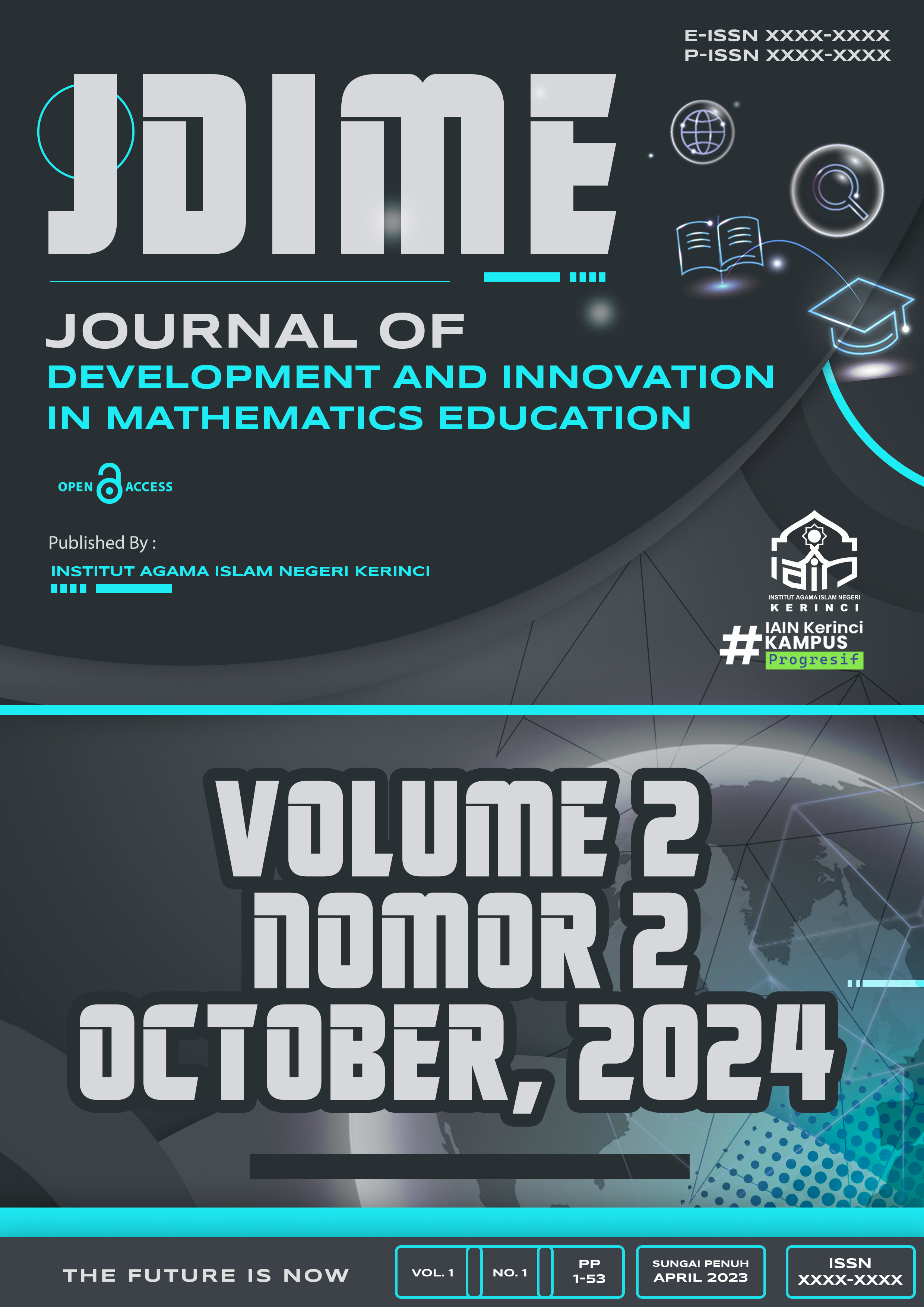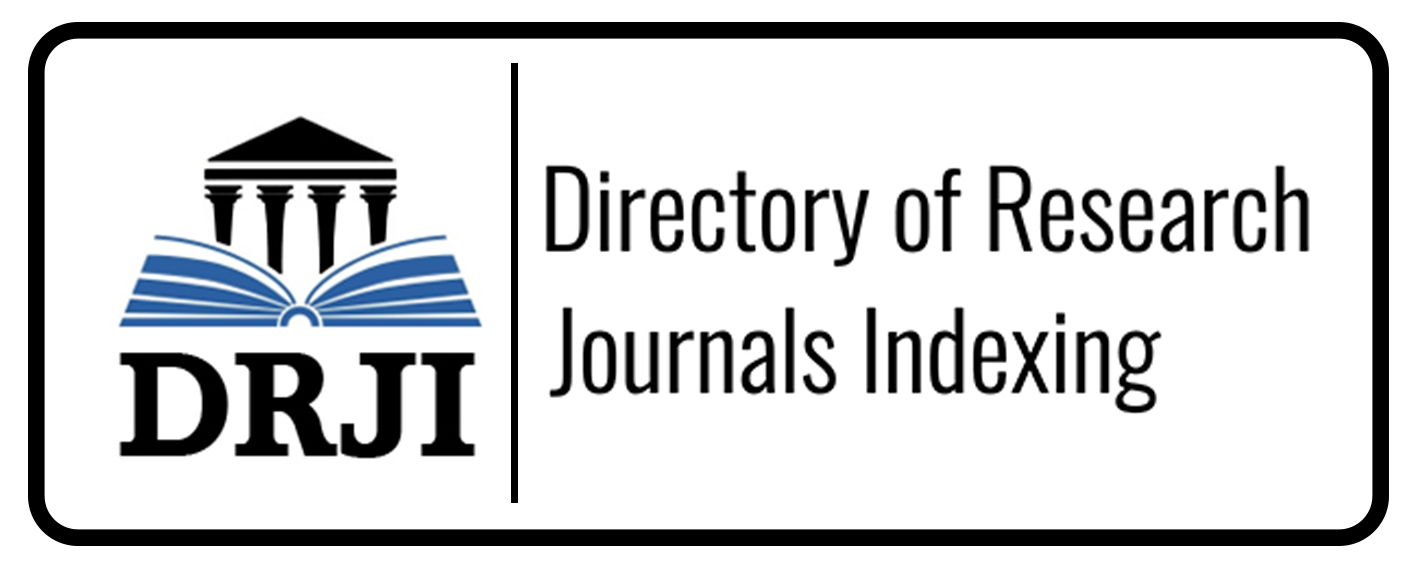Development of the Smartphone-Based Edutainment Game “MathVenture” as a Learning Medium Oriented Towards Creative Thinking Skills
Abstract
This study aims to develop and evaluate MathVenture, a smartphone-based educational game designed to enhance students' creative thinking and engagement in mathematics learning. The development process followed the ADDIE model, consisting of five phases: Analysis, Design, Development, Implementation, and Evaluation. The study involved 30 students and 10 teachers from a Junior High School. Data were collected through pre- and post-tests to assess students' creative thinking, as well as questionnaires to evaluate the practicality of the game from both students' and teachers' perspectives. The pre-test and post-test results showed a significant increase in students' creative thinking scores, with an average pre-test score of 8.0 and a post-test score of 13.0 (t = 5.00, p < 0.05). The game received high usability ratings, with the teachers' average score for practicality being 4.29 (Very Good), and the students' average score being 4.82 (Very Good). The study concludes that MathVenture is an effective tool for enhancing creative thinking and student motivation in mathematics learning, contributing to the growing body of research on game-based learning in education.
Downloads
References
Ally, M., & Tsinakos, A. (2014). Perspectives on open and distance learning: Increasing access through mobile learning. Commonwealth of Learning.
An, Y., & Cao, L. (2020). The effects of game-based learning on students’ critical thinking: A meta-analysis. Journal of Educational Computing Research, 57(7), 1725–1749. https://doi.org/10.1177/0735633118825391
Anastasiadis, T., Lampropoulos, G., & Siakas, K. (2018). Digital game-based learning and serious games in education. International Journal of Advances in Scientific Research and Engineering, 4(12), 139–144. https://doi.org/10.31695/IJASRE.2018.33012
Anderson, L. W., Krathwohl, D. R., & Airasian, P. W. (2014). A taxonomy for learning, teaching, and assessing: A revision of Bloom's taxonomy of educational objectives. Pearson Education.
Ardiansyah, A., Rosnawati, R., & Jailani, J. (2022). Enhancing students’ higher-order thinking skills using interactive mathematics learning media. Journal on Mathematics Education, 13(1), 85–98. https://doi.org/10.22342/jme.v13i1.15299
Arends, R. I. (2015). Learning to teach (10th ed.). McGraw-Hill Education.
Ariffin, M. K. A. M., Din, R., Halim, N. D. A., & Halim, A. A. (2020). Designing a culturally responsive mathematics mobile application for indigenous learners. Journal of Educational Computing Research, 58(4), 777–800. https://doi.org/10.1177/0735633119877643
Asrial, A., Syahrial, S., Perdana, R., Nugroho, R. A., & Wahyu, Y. A. (2021). The development of mobile learning based on local wisdom to improve students’ creative thinking skills. International Journal of Instruction, 14(1), 781–798. https://doi.org/10.29333/iji.2021.14147a
Defining twenty-first-century skills. In P. Griffin, B. McGaw, & E. Care (Eds.), Assessment and teaching of 21st century skills (pp. 17–66). Springer. https://doi.org/10.1007/978-94-007-2324-5_2
Branch, R. M. (2009). Instructional design: The ADDIE approach. Springer.
Chen, C. M., & Huang, Y. M. (2020). The effects of using educational game to enhance students’ learning performance in mathematics. Educational Technology Research and Development, 68(3), 939-958. https://doi.org/10.1007/s11423-020-09787-4
Cheng, M. T., Lin, Y. W., & She, H. C. (2019). Learning through playing virtual age: Exploring the interactions among student concept learning, gaming performance, in-game behaviors, and the use of in-game characters. Computers & Education, 142, 103643. https://doi.org/10.1016/j.compedu.2019.103643
Cheng, M.-T., Lin, Y.-W., She, H.-C., & Kuo, P.-C. (2019). The effects of game-based learning on mathematical reasoning ability and attitudes toward mathematics. Educational Technology & Society, 22(2), 106–118. https://www.jstor.org/stable/26819529
Chou, P. N., Block, L., & Jesness, R. (2012). A case study of mobile learning pilot project in K-12 schools. Journal of Educational Technology Development and Exchange, 5(2), 11–26. https://doi.org/10.18785/jetde.0502.02
Cohen, L., Manion, L., & Morrison, K. (2018). Research methods in education (8th ed.). Routledge.
Creswell, J. W., & Creswell, J. D. (2017). Research design: Qualitative, quantitative, and mixed methods approaches (5th ed.). Sage Publications.
Crompton, H., & Burke, D. (2018). The use of mobile learning in PK-12 education: A systematic review. Computers & Education, 123, 53–64. https://doi.org/10.1016/j.compedu.2018.04.007
Darmaji, D., Kurniawan, D. A., Astalini, A., & Anggraini, L. (2019). The analysis of students’ science process skills in physics laboratory. International Journal of Scientific and Technology Research, 8(10), 1100–1105.
Daryanto, & Karim, S. (2021). Pengembangan media pembelajaran matematika berbasis budaya lokal untuk meningkatkan kemampuan berpikir kreatif siswa. Jurnal Pendidikan Matematika, 15(1), 45–58. https://doi.org/10.22342/jpm.v15i1.12345
Deci, E. L., & Ryan, R. M. (2000). Intrinsic and extrinsic motivations: Classic definitions and new directions. Contemporary Educational Psychology, 25(1), 54-67. https://doi.org/10.1006/ceps.1999.1020
Farida, I., Hakim, R., & Cahyani, D. (2023). The role of mobile learning in shaping independent and meaningful learning in mathematics. Journal of Educational Multimedia and Hypermedia, 32(1), 23–39.
Field, A. (2018). Discovering statistics using IBM SPSS statistics (5th ed.). Sage Publications.
Fitria, Y., Putra, A., & Anggraini, D. (2020). The effect of student worksheet based on problem-based learning to student learning outcomes. International Journal of Progressive Sciences and Technologies, 20(1), 269–274.
Fitriani, I., Maulana, I., & Wahyuni, S. (2023). Gamification in mathematics learning: Increasing students' motivation and achievement. International Journal of Instructional Technology and Educational Studies, 10(2), 66–72.
Garton, S., Copland, F., & Burns, A. (2017). Challenges in teaching English to young learners: Global perspectives and local realities. TESOL Quarterly, 51(3), 565–572. https://doi.org/10.1002/tesq.363
Gee, J. P. (2013). Games, learning, and society: Learning and meaning in the digital age. Cambridge University Press.
Gee, J. P. (2013). Good video games + good learning: Collected essays on video games, learning, and literacy (2nd ed.). Peter Lang Publishing.
Gee, J. P. (2013). The anti-education era: Creating smarter students through digital learning. Palgrave Macmillan.
Gunawan, G., Harjono, A., & Rahayu, S. (2020). The impact of inquiry learning model on student mathematical creative thinking ability. International Journal of Instruction, 13(3), 73–90. https://doi.org/10.29333/iji.2020.1336a
Gustafson, K. L., & Branch, R. M. (2002). Survey of instructional development models (4th ed.). Syracuse University.
Hamari, J., Koivisto, J., & Sarsa, H. (2014). Does gamification work? – A literature review of empirical studies on gamification. In Proceedings of the 47th Hawaii International Conference on System Sciences (pp. 3025–3034). IEEE. https://doi.org/10.1109/HICSS.2014.377
Hamari, J., Koivisto, J., & Sarsa, H. (2014). Does gamification work?—A literature review of empirical studies on gamification. In Proceedings of the 47th Hawaii International Conference on System Sciences (pp. 3025–3034). IEEE. https://doi.org/10.1109/HICSS.2014.377
Harrell, M. C., & Bradley, M. A. (2018). Data collection methods: Semi-structured interviews and focus groups. RAND Corporation.
Hermita, N., Zetra, H., & Anwar, R. (2020). Pengaruh model pembelajaran berbasis masalah terhadap kemampuan berpikir kreatif matematis. Jurnal Pendidikan Matematika Raflesia, 5(2), 84–92.
Hidayat, R. (2018). Pembelajaran berbasis mobile learning dalam pendidikan abad 21. Jurnal Teknologi Pendidikan, 20(3), 261–273.
Hidayat, R. (2018). Penggunaan teknologi dalam pendidikan: Sebuah pendekatan pedagogis. Jurnal Teknologi Pendidikan, 16(2), 34-45.
Hosnan, M. (2017). Pendekatan saintifik dan kontekstual dalam pembelajaran abad 21. Ghalia Indonesia.
Hung, C. M., Hwang, G. J., & Huang, I. (2014). A project-based digital storytelling approach for improving students' learning motivation, problem-solving competence and learning achievement. Educational Technology & Society, 17(4), 368–379.
Hussein, M. H., Ow, S. H., Cheong, L. S., Thong, M. K., & Dhinagaran, D. A. (2019). Game-based learning and gamification: A review of literature. Asian Journal of Research in Education and Social Sciences, 1(1), 1–10.
Hwang, G. J., & Tsai, C. C. (2017). Trends in research on mobile learning in mathematics: A review of publications in selected journals from 2007 to 2016. International Journal of Mobile Learning and Organisation, 11(3), 256–277. https://doi.org/10.1504/IJMLO.2017.085221
Isnawati, I., Sudibyo, E., & Prihatin, J. (2022). Effect of game-based learning model on students’ creative thinking skills and motivation in mathematics. Journal of Physics: Conference Series, 2049(1), 012080. https://doi.org/10.1088/1742-6596/2049/1/012080
Jonassen, D. H. (2014). Handbook of research on educational communications and technology. Springer.
Ke, F. (2008). A case study of computer gaming for math: Engaged learning from gameplay? Computers & Education, 51(4), 1609–1620. https://doi.org/10.1016/j.compedu.2008.03.003
Kimmons, R. (2018). Open Textbooks and Student Learning. Educational Technology Research and Development, 66(1), 123-135.
Likert, R. (1932). A technique for the measurement of attitudes. Archives of Psychology, 140, 1-55.
Mekler, E. D., Brühlmann, F., Tuch, A. N., & Opwis, K. (2017). Towards understanding the effects of individual gamification elements on intrinsic motivation and performance. Computers in Human Behavior, 71, 525–534. https://doi.org/10.1016/j.chb.2015.08.048
Mishra, P., Henriksen, D., & Mehta, R. (2021). Creativity and education: Integrating creative thinking across the curriculum. Educational Technology, 61(1), 30–37.
Molenda, M. (2015). In search of the elusive ADDIE model. Performance Improvement, 54(2), 40-42. https://doi.org/10.1002/pfi.21461
Muhtadi, D., Wahyudin, W., & Kartasasmita, B. G. (2019). Enhancing students' creative mathematical thinking ability through problem-based learning with ICT. Journal of Physics: Conference Series, 1157(3), 032111. https://doi.org/10.1088/1742-6596/1157/3/032111
Nasir, M., Yusuf, M., & Jannah, M. (2020). Ethnomathematics in Sasak traditional game: Media for learning mathematics and preserving culture. Journal of Physics: Conference Series, 1470, 012020. https://doi.org/10.1088/1742-6596/1470/1/012020
Nouri, J., & Shahid, S. (2019). The impact of interactive media on learning outcomes in education. Journal of Educational Technology & Society, 22(4), 123-136. https://www.jstor.org/stable/26826746
Nugroho, A. A., Santoso, H. B., & Zainuri, A. (2020). Learning media based on smartphone applications to enhance students’ understanding in linear algebra. International Journal of Interactive Mobile Technologies, 14(5), 58–71.
OECD. (2018). The future of education and skills: Education 2030. OECD Publishing. https://www.oecd.org/education/2030-project/
OECD. (2019). PISA 2018 results (Volume I): What students know and can do. OECD Publishing. https://doi.org/10.1787/5f07c754-en
Pallant, J. (2016). SPSS survival manual: A step by step guide to data analysis using IBM SPSS (6th ed.). McGraw-Hill Education.
Pilli, O., & Aksu, M. (2021). The role of curriculum alignment in educational game design. Journal of Computer Assisted Learning, 37(2), 451-465. https://doi.org/10.1111/jcal.12451
Pratama, Y. A., Fajriyah, U., & Kurniawan, D. A. (2023). Digital interactive media in mathematics instruction: Supporting 21st-century skills development. Jurnal Pendidikan Matematika, 17(2), 215–230.
Prensky, M. (2012). From digital natives to digital wisdom: Hopeful essays for 21st century learning. Corwin Press.
Qian, M., & Clark, K. R. (2016). Game-based learning and 21st century skills: A review of recent research. Computers in Human Behavior, 63, 50–58. https://doi.org/10.1016/j.chb.2016.05.023
Ramdhani, M. A., Setiawan, A., & Azis, Y. (2023). Pengembangan game edukatif untuk meningkatkan kemampuan berpikir kreatif siswa sekolah dasar. Jurnal Teknologi Pendidikan, 25(2), 167–178. https://doi.org/10.21009/jtp.v25i2.30567
Randel, J. M., Morris, B. A., Wetzel, C. D., & Whitehill, B. V. (2019). The effectiveness of games for educational purposes: A review of recent research. Simulation & Gaming, 50(4), 467-489. https://doi.org/10.1177/1046878118781463
Redecker, C., Punie, Y., & Ferrari, A. (2020). Learning for creativity and innovation. In OECD (Ed.), Innovating education and educating for innovation (pp. 55–77). OECD Publishing.
Riyadi, R., & Aulia, N. R. (2021). The impact of mathematical learning media on students' engagement. Journal of Physics: Conference Series, 1720, 012042. https://doi.org/10.1088/1742-6596/1720/1/012042
Rusman, R. (2018). Model-model pembelajaran: Mengembangkan profesionalisme guru. Jurnal Pendidikan dan Kebudayaan, 23(3), 21-35.
Rusman. (2018). Model-model pembelajaran: Mengembangkan profesionalisme guru. PT RajaGrafindo Persada.
Sa’diyah, N., Hidayati, N., & Maulana, H. (2023). The effect of mathematics gamification on students’ learning motivation. International Journal of Education and Learning, 5(1), 18–26.
Sahid, A., Permana, Y., & Lestari, H. (2021). Smartphone-based learning media to increase students’ independence and critical thinking. Jurnal Pendidikan Teknologi dan Kejuruan, 27(2), 122–131.
Schleicher, A. (2020). PISA 2018 insights and interpretations. OECD Publishing.
Setiawan, R., Wibowo, C. A., & Rochmadi, R. (2020). Pengaruh game edukasi matematika terhadap kemampuan berpikir kreatif siswa SMP. Jurnal Pendidikan Matematika, 14(2), 112–124. https://doi.org/10.22342/jpm.v14i2.1234
Shi, L., & Cristea, A. I. (2016). Making it game-like: Top 10 gamification elements for LMSs. International Journal of Emerging Technologies in Learning, 11(7), 4–9. https://doi.org/10.3991/ijet.v11i07.5885
Simões, J., Redondo, R. D., & Vilas, A. F. (2021). A social gamification framework for a K-6 learning platform. Computers in Human Behavior, 57, 177–187. https://doi.org/10.1016/j.chb.2015.12.019
Su, C. H., Cheng, C. H., & Lin, C. H. (2021). Investigating the effects of game-based learning and content integration on mathematical learning outcomes and motivation. Interactive Learning Environments, 29(4), 648–661. https://doi.org/10.1080/10494820.2019.1610450
Subhash, S., & Cudney, E. A. (2018). Gamified learning in higher education: A systematic review of the literature. Computers in Human Behavior, 87, 192–206. https://doi.org/10.1016/j.chb.2018.05.028
Sugiyono. (2018). Metode Penelitian Pendidikan: Pendekatan Kuantitatif, Kualitatif, dan R&D. Alfabeta.
Suh, A., & Wagner, C. (2013). Gamification in the workplace: The central role of the aesthetic experience. Journal of Management Information Systems, 30(3), 367-391. https://doi.org/10.2753/MIS0742-1222300309
Suh, A., & Wagner, C. (2013). The effects of gamification on learning: A case study of a university-level course. Journal of Computer Assisted Learning, 29(3), 256–267. https://doi.org/10.1111/jcal.12020
Suh, A., Wagner, C., & Liu, L. (2018). Enhancing user engagement through gamification. Journal of Computer Information Systems, 58(3), 204–213. https://doi.org/10.1080/08874417.2016.1229143
Suherman, E., & Wahyudin, W. (2019). Pengaruh metode pembelajaran berbasis masalah terhadap kemampuan berpikir kreatif matematis siswa. Jurnal Pendidikan Matematika, 13(1), 73-88. https://doi.org/10.22342/jpm.13.1.4512.73-88
Suherman, E., & Wahyudin. (2019). Pembelajaran matematika yang bermakna: Upaya menumbuhkan minat dan kreativitas siswa. Jurnal Pendidikan Matematika Indonesia, 4(1), 23–30.
Sung, Y. T., Chang, K. E., & Liu, T. C. (2016). The effects of integrating mobile devices with teaching and learning on students’ learning performance: A meta-analysis and research synthesis. Computers & Education, 94, 252–275. https://doi.org/10.1016/j.compedu.2015.11.008
Suryani, I., Nugroho, Y., & Lestari, H. (2022). Pengembangan media pembelajaran berbasis smartphone untuk meningkatkan kemampuan berpikir tingkat tinggi. Jurnal Teknologi Pendidikan, 24(3), 201–210.
Susanti, A., & Roza, Y. (2022). Analisis faktor penyebab rendahnya motivasi belajar matematika siswa. Jurnal Ilmiah Pendidikan Matematika Al Qalasadi, 6(2), 123–130.
Sweeney, J., Lam, D., & Williams, D. (2019). Designing and evaluating digital learning games for K-12 classrooms. Journal of Educational Computing Research, 56(2), 269-293. https://doi.org/10.1177/0735633118814835
Syahrir, S., Hasan, M., & Saputra, W. (2022). Ethnomathematics-based mobile learning for Indonesian elementary students. International Journal of Interactive Mobile Technologies, 16(12), 55–66. https://doi.org/10.3991/ijim.v16i12.30015
Taspinar, B., Schmidt, W., & Schuhbauer, H. (2016). Gamification in education: A board game approach to knowledge acquisition. Procedia Computer Science, 99, 101-116. https://doi.org/10.1016/j.procs.2016.09.104
Torrance, E. P. (2008). Torrance Tests of Creative Thinking: Technical manual. Scholastic Testing Service.
Trilling, B., & Fadel, C. (2009). 21st century skills: Learning for life in our times. John Wiley & Sons.
Tsai, Y. C., Yu, K. C., & Hsiao, H. S. (2018). Exploring the factors influencing learning effectiveness in digital game-based learning. Educational Technology & Society, 21(3), 233–247.
Tuckman, B. W. (2012). Conducting educational research (6th ed.). Wadsworth.
UNESCO. (2021). Reimagining our futures together: A new social contract for education. UNESCO Publishing.
Van Laar, E., Van Deursen, A. J. A. M., Van Dijk, J. A. G. M., & De Haan, J. (2020). Determinants of 21st-century digital skills: A large-scale survey among working professionals. Computers in Human Behavior, 100, 93–104. https://doi.org/10.1016/j.chb.2019.06.017
Voogt, J., & Roblin, N. P. (2012). A comparative analysis of international frameworks for 21st century competences: Implications for national curriculum policies. Journal of Curriculum Studies, 44(3), 299-321. https://doi.org/10.1080/00220272.2012.668938
Vygotsky, L. S. (1978). Mind in society: The development of higher psychological processes. Harvard University Press.
Wijaya, A., Retnawati, H., & Mardapi, D. (2021). Using digital games to foster students’ motivation and creative thinking in mathematics. Education and Information Technologies, 26, 2345–2360. https://doi.org/10.1007/s10639-020-10388-3
Wijaya, A., Sumarmo, U., & Herman, T. (2020). Improving students’ mathematical creativity through problem-based learning. Journal on Mathematics Education, 11(3), 391–404. https://doi.org/10.22342/jme.11.3.11712.391-404
Yilmaz, R. M., & Baydas, O. (2017). An examination of undergraduates’ attitudes towards use of mobile learning. Education and Information Technologies, 22(6), 2511–2525. https://doi.org/10.1007/s10639-016-9563-1
Zubaidah, S. (2022). Pembelajaran abad ke-21 dan implementasinya dalam pembelajaran. Jurnal Pendidikan dan Pembelajaran, 29(1), 1–12.
Copyright (c) 2024 Hermansyah Hermansyah, Eka Widyawati

This work is licensed under a Creative Commons Attribution 4.0 International License.



























 JDIME: Journal of Development and Innovation in Mathematics Education (e-ISSN
JDIME: Journal of Development and Innovation in Mathematics Education (e-ISSN 
